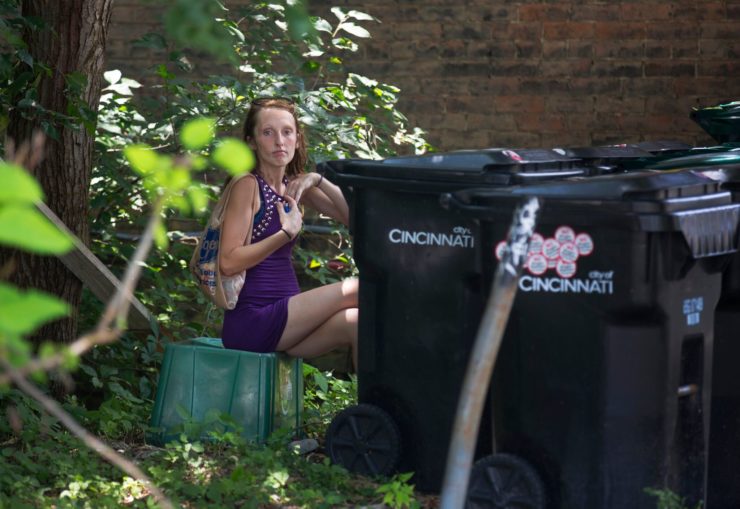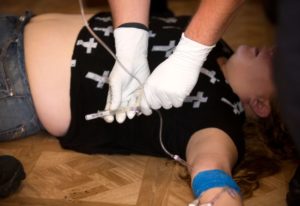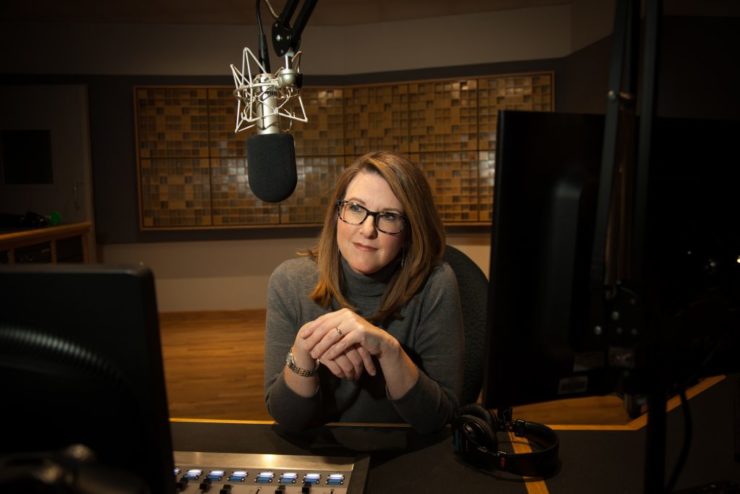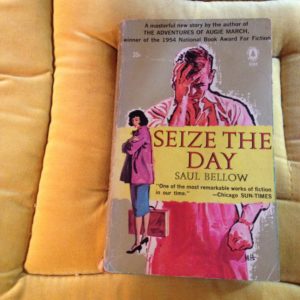
Ali, 25, crouches behind garbage bins before shooting drugs.
Two of the biggest stories in America today are the culture wars that seem to be deepening the divide in the country and the opioid crisis that is devastating a huge swath of rural and urban America. When it comes to the latter, The Cincinnati Enquirer did a standout job with a humane, microscopic look at seven days of addiction in the city. In the former, reporters at The New York Times Magazine and The Washington Post also went extreme close-up for their stories on Islamophobia in two small towns. And radio reporter Krys Boyd deals with both types of topics on her deep-dive news program “Think.”

Covington paramedics administer naloxone intravenously to Gracie Centers after she overdosed.
The Cincinnati Enquirer’s stunning “Seven Days of Heroin.” I’m not sure when I’ve been more impressed this year by a newspaper’s commitment to a project — a mind-boggling 60 staffers were involved. But the huge scale of the reporting is in direct contrast to the result: The story is told in the smallest scale possible, providing an intimate look at the opioid crisis. As lead writer Terry DeMio says, “We just wanted to show people: This is what a heroin epidemic looks like.” Bravo to the Enquirer for its creativity and willingness to use so many of its resources for this beautiful piece.
The soundtrack: “Heroin,” by the Velvet Underground. This is a pretty shattering description of what being a junkie does to your body, and your soul: “‘Cause when the smack begins to flow/And I really don’t care anymore/Ah, when that heroin is in my blood/And that blood is in my head/Then thank God that I’m as good as dead.”
One Great Sentence:
“Something in the world links faces and leaves and rivers and woods and wind together and makes them a string of medallions with all our faces on them, worn forever round our necks, kin.”
William Goyen, “House of Breath,” 1950. Read why we think it’s great.

"Think" host Krys Boyd.
Texas journalist Krys Boyd and the art of the radio interview. Boyd has had a lot of practice when it comes to the art of the radio interview: She’s been doing it five days a week for 11 years now. Wow. I really like what she had to say about radio and storytelling. Radio, she says, is an oral form of storytelling, and rumors of its imminent demise notwithstanding, she’s a big believer in its future. “People have been talking for a long time about how the medium of radio is destined to go away, and I think that the huge interest among young people in the podcast format proves that’s not true,” she says. “I think it’s stronger than ever, and it’s being creatively done.”
The soundtrack: “A Question Isn’t Answered,” by Temples. This band does fun ’60s-inspired psychedelic pop. I saw them a few years back at Coachella, and it was the rebirth of shoegazing, 30 years on. They stood so still and were so withdrawn, it was like a James Brown moment when they so much as took a (tentative) step forward.
What I’m reading online: This week, two stories about the culture wars in America, specifically about Islamophobia, bought my eye.
“A Showdown Over Sharia,” by Robert Samuels. I’m glad Samuels, a Washington Post reporter, put this story on my radar. (For the record, I love when editors and reporters point out stories they’re proud of. Keep them coming!) I was immediately sold on the words in the link alone: “Muslims and anti-Sharia activists meet armed at a Dairy Queen.” Isn’t that a good summation of America in 2017? The story has some amazing quotes, including this one: “The Muslims make me nervous. They went to my hometown and tried to shoot people. This is Texas. You ain’t gonna do that in Texas. I don’t think so. We will kill you first.”
“How Fake News Turned a Small Town Upside Down,” by Caitlin Dickerson. This New York Times Magazine story will send a chill down the spine of every journalist, and hopefully a lot of other Americans too. It tells the story of how anti-Muslim propaganda spread like wildfire in the absence of facts in the aftermath of a murky attack in Twin Falls, Idaho. It’s sobering, to say the least. And this quote is an eerie echo of the one in the story above: “They are not compatible with our culture,” she said. “They hate us. They don’t want to be Americans. They don’t want to assimilate. What do you need to see? What more proof do you need?”
 What’s on my bedside table: “Seize the Day,” by Saul Bellow. I’m not sure why, but I love when serious works of fiction get the pulp treatment. This cover! The man with his head in his hand, the other hand clenched in a fist. The woman with her crossed arms and high heels. It captures the emotion of the book, which follows a middle-aged man who’s falling apart on one day of crisis. How about this killer line? “You can spend the entire second half of your life recovering from the mistakes of the first half. ”
What’s on my bedside table: “Seize the Day,” by Saul Bellow. I’m not sure why, but I love when serious works of fiction get the pulp treatment. This cover! The man with his head in his hand, the other hand clenched in a fist. The woman with her crossed arms and high heels. It captures the emotion of the book, which follows a middle-aged man who’s falling apart on one day of crisis. How about this killer line? “You can spend the entire second half of your life recovering from the mistakes of the first half. ”
 What’s on my turntable: “Bandwagonesque,” by Benjamin Gibbard. A very cool outfit known as Turntable Kitchen is releasing a series of full-album covers this year. (I’m dying to know how Foxygen’s Jonathan Rado covers “Born to Run.”) This album by Death Cab for Cutie’s Gibbard manages to make one of the most perfect pop albums of all time, by the brilliant Teenage Fanclub, even poppier. I’ve had it on repeat for weeks on Spotify, and am jazzed to finally have it on vinyl too.
What’s on my turntable: “Bandwagonesque,” by Benjamin Gibbard. A very cool outfit known as Turntable Kitchen is releasing a series of full-album covers this year. (I’m dying to know how Foxygen’s Jonathan Rado covers “Born to Run.”) This album by Death Cab for Cutie’s Gibbard manages to make one of the most perfect pop albums of all time, by the brilliant Teenage Fanclub, even poppier. I’ve had it on repeat for weeks on Spotify, and am jazzed to finally have it on vinyl too.
If you want to chat about storytelling (or music), I’m Storyboard editor Kari Howard, and you can reach me at editor@niemanstoryboard.org. Or you can find me at @karihow on Twitter.


